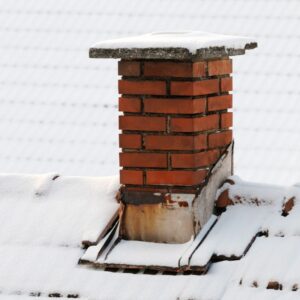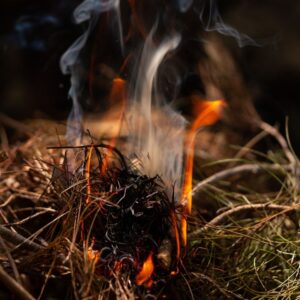Imagine you get home from a long day at work… The temperature has dropped and all you want is to settle down in front of a nice warm fire. You gather your firewood and meticulously arrange it in the firebox. You go to light it, but find that it is seemingly impossible to get it to burn without going out.
Instead of dancing flames all you see is smoke billowing – and not up the chimney like it’s supposed to, but into your living room instead.
Properly priming (preheating) your chimney for a fire can make all the difference between enjoying a strong, warm, efficient fire or having a smoky, uncomfortable fire that is struggling to burn.
Read up on our tips to ensure the most efficient fireplace fires possible. Need chimney sweep or fireplace repair services? Don’t hesitate to reach out – we’ve got you covered.
Why Can’t I Start a Fire With a Cold Chimney?
 When starting a fire in a fireplace or wood stove with a cold chimney, warm air that is meant to rise up and establish a proper outward draft is prevented from doing so because cold air is heavier – and therefore ends up pushing everything back down.
When starting a fire in a fireplace or wood stove with a cold chimney, warm air that is meant to rise up and establish a proper outward draft is prevented from doing so because cold air is heavier – and therefore ends up pushing everything back down.
Instead, a downdraft can be introduced, which means any smoke created has nowhere to go except for into your living space. What results is an uncomfortable evening just trying to breathe, all while you try desperately to get smoke, and its smell, out of your house…not so much the cozy evening you’d likely been envisioning.
And if you do finally get some flames going? The cold chimney can still cause problems by creating an inefficient burn and leading to a heightened buildup of creosote (and all the dangers that come with it).
How to Prime Your Chimney Flue
Fortunately, there are easy ways to prime your chimney before lighting a fire. Priming your chimney involves heating up the flue, establishing proper airflow, and creating an environment within your fireplace, wood stove, and chimney where a safe and efficient fire can roar.
Here are some tips on getting your chimney ready to play host to a beautiful fire.
✓ Use Proper Kindling for a Gradual Buildup
 The goal of priming a chimney is to get it warm before your flames really get going. It’s understandable to want a strong fire the second you light your logs…however, it’s also unrealistic.
The goal of priming a chimney is to get it warm before your flames really get going. It’s understandable to want a strong fire the second you light your logs…however, it’s also unrealistic.
Kindling is a small, easily combustible material that gives off heat, but doesn’t cause big flames. Instead of immediately using large logs, begin with a layer of kindling. This allows for a gradual buildup of heat in the chimney, promoting a steady and efficient burn. As the kindling ignites, the temperature in the flue increases, helping to overcome the initial cold barrier.
✓ Open the Damper
One of the things we see happen all the time is chimney dampers remaining closed while the fire is being lit. The damper is crucial in controlling airflow in and out of your chimney. When closed, they don’t let cold air from outside get into your house. However, when having a fire in your fireplace it is absolutely necessary to make sure that the damper is open. The open damper will allow air to supply your fire with oxygen, while allowing heat to warm your flue and create proper drafting for a strong fire.
✓ Warm the Firebox
In addition to priming the flue, it’s a good idea to warm the firebox itself. Cold masonry or metal in the firebox can absorb heat, reducing the overall efficiency of the fire. To address this, carefully use a handheld blow dryer or fireplace matches to warm the firebox before adding larger pieces of wood. This ensures that the fire starts with a strong foundation and minimizes the risk of excessive smoke.
✓ Use a Chimney Starter
A chimney starter is a metal cylinder with ventilation holes around it. It is designed to rapidly ignite a concentrated amount of kindling, such as wood chips. This means that the heat from the kindling is quickly dispersed into the chimney flue, warming it up and establishing an upward draft.
To use the chimney starter, simply place it in the fireplace and on the grate if you have one, then fill it with dry wood shavings, pellets, or chips. Light the wood with a match or lighter and let the heat generated warm up the flue. After a few minutes, there should be an upward draft that prepares the chimney for a successful fire.
✓ Choose Seasoned Firewood
It is important to use the right type of firewood to make sure that your fire burns at maximum efficiency. Seasoned firewood that has been allowed to dry for at least six months will burn cleanly. This minimizes the buildup of creosote in the flue giving you a stronger, warmer, and safer fire.
✓ Book Regular Chimney Maintenance
Priming your chimney is not a one-time task – it’s part of a comprehensive approach to chimney care and maintenance. It is important to regularly have your chimney annually inspected to make sure there aren’t cracks and hazards that lead to dangerous fires. It’s also important to have your chimney cleaned to remove any creosote buildup, debris, or blockages. A clean chimney ensures proper airflow and reduces the risk of chimney fires and smoke intrusion.
Give Us a Call Today
At Smalling Masonry, our professionals are trained to keep chimneys working optimally, ensuring you stay warmer and cozier during these cold winter months. Call us today and schedule a professional chimney inspection and cleaning. You can also reach out online. Thanks for choosing us!
